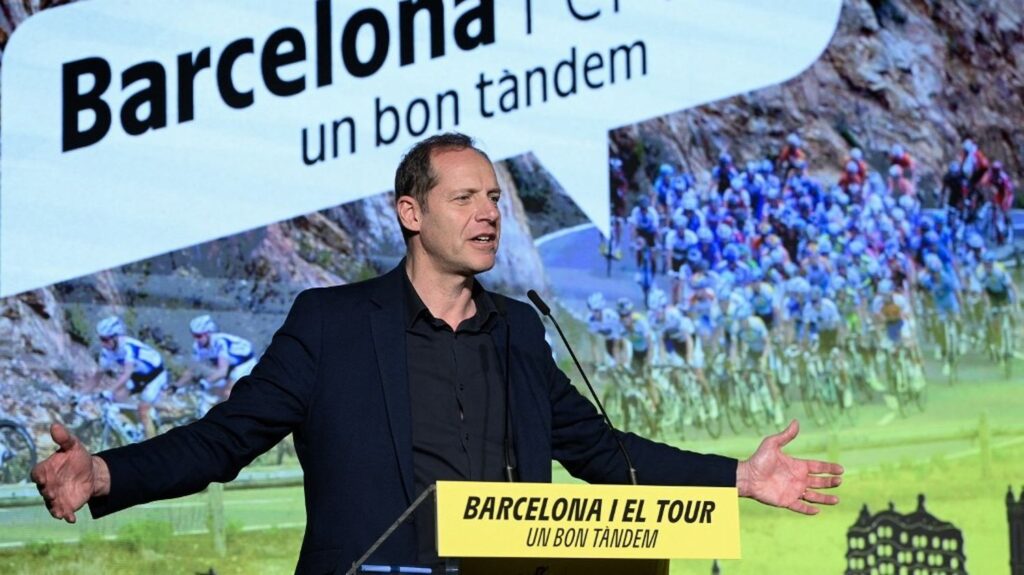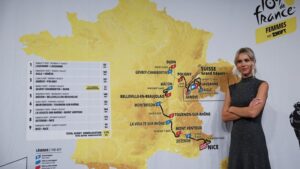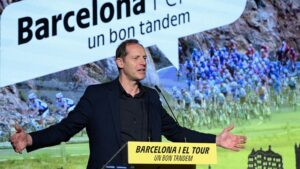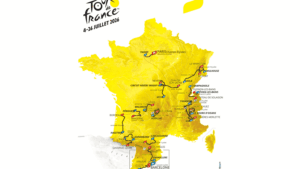
The route for the 113th edition of the Tour de France was revealed on Thursday October 23 in Paris. After the Grand Départ in Barcelona, the peloton will quickly cross the Pyrenees, before a long climb towards the Vosges via the Massif Central, and above all an unprecedented final bouquet in the Alps. With, as a highlight, the two successive arrivals at Alpe d'Huez, on the eve of that on the Champs-Elysées. A journey that Christian Prudhomme deciphers, for franceinfo: sport.
Franceinfo: sport: Before going into detail, how would you summarize the journey of this 113th edition?
Christian Prudhomme : The word that sums it up best is crescendo. We will start strong from Barcelona, then we will cross the five major French mountain ranges, to finish with an unprecedented finale. Before the double Alpe d'Huez, no rider will be able to say three days before the finish that he has won the Tour, even if he has a big lead. On this edition, there will be five arrivals at the summit, including three on the three days preceding the arrival in Paris: the one at Orcières Merlette on Thursday, then the two in a row at Alpe d'Huez, with 5 600 meters of positive altitude difference on the eve of arrival in Paris. On the morning of the 19th stage, even if the yellow jersey is five minutes ahead, he will not be able to say that he has won.
/2025/10/22/copie-de-xs-68f938682d7c0275909096.png)
The Tour de France will start from Spain, in Barcelona. After the events that occurred at the last Vuelta around the Israel-Premier Tech team, was this Grand Départ ever threatened?
No. The international situation, which does not depend on us, has changed. It has tended to evolve in the right direction in recent weeks, which does not prejudge the situation in July. Furthermore, in the world of cycling, the declarations of the team concerned, which will have a new name and a new license, mean that things have calmed down. And Barcelona has always told us that it wants to make its Grand Départ the biggest in history.
This Grand Départ will also mark the return of the team time trial to start the race, a first in 55 years. Why this choice?
The choice, already, is Barcelona. Because it is a prestigious city, an Olympic city. For me as for many, Barcelona is Marie-José Pérec 1992. Because it is a city which hosted the Football World Cup, which has an F1 Grand Prix and who has seen the Tour pass three times. Second reason: Barcelona is beautiful. Third reason: it is the Montjuïc hill. From the start, we will have the champions shoulder to shoulder with this team time trial which will arrive in this Montjuïc hill. A side that we will repeat three times the next day, and where the last three winners are Remco Evenepoel, Tadej Pogacar and Primoz Roglic. It will set the tone!
With a departure from Barcelona, we could not avoid the Pyrenees at the start. Isn't it too early?
Yes, we arrive quickly in the Pyrenees, arriving at Les Angles at the summit from the 3rd stage. So the mountains arrive quickly, but we made sure not to get too hard during the three days we spent in the Pyrenees. There will still be the classic Aspin-Tourmalet, with 4 150 meters of positive elevation. But also an arrival at the Gavarnie circus, which had been applying for a long time, and which corresponded to our desire this year in the Pyrenees: to show beauty, without it being too hard for the first week. Gavarnie is long at 20 km, but only at 4%.
Tourmalet, Galibier, Alpe d'Huez… The monuments of the Tour are on the menu, but what are the new features that will make you salivate in anticipation: the Gavarnie cirque? The Solaison plateau? The Haag Pass?
It's difficult to highlight one, because when we propose a new climb on the Tour, it's the riders who enhance it or not. If two champions fight over it, that's great, as was the case at Granon in 2022 with the duel between Jonas Vingegaard and Tadej Pogacar. The Gavarnie cirque is more beautiful than hard, even if it is long.
The Solaison plateau has been on the Dauphiné program twice recently, so we know that it is not an easy climb, especially since there is Mont Salève before the return (4.7 km at 11%). It's a very steep climb, beautiful scenery, with the rest day the next day, so it's going to hurt. And the Haag is part of our research for high percentages in other mountain ranges. And there, we have them on this stage from Mulhouse to Markstein (14th stage). The Haag is a climb of the future, in the forest, where spectators will be well seated all day long. With global warming, as soon as we find a very rough, very steep climb in the undergrowth, like the Haag, we throw ourselves at it.
Between leaving the Pyrenees and arriving in the Alps, there will be ten days. How did you think about the route to punctuate this period?
We use the five massifs precisely for this. For 15 years, we have been trying to show that we can do major stages outside the Alps and the Pyrenees. The first week of the 2025 Tour between the North and Brittany clearly showed this. People now understand that there are not only the Alps and the Pyrenees on the Tour. There, for example, we return to Lioran for July 14 where, in 2022, there is almost a photo finish between Pogacar and Vingegaard. The Markstein stage is the same: the last winner is called Pogacar.
“Today, Pogacar, Vingegaard, Evenepoel, they know that it can be played in the Massif Central too, on shorter but sometimes steeper slopes”
Christian Prudhommeat franceinfo: sport
We want to address all people, not just cycling experts. But it takes recurrence to make people understand that a region can be spectacular, which we have achieved in recent years with the Massif Central and the Vosges, in particular. We have a range of difficulties everywhere now.
/2025/10/22/14-juillet-68f91091e56c2362475044.png)
Conversely, the two consecutive arrivals at Alpe d'Huez will cause a lot of noise. Even if they are two very different arrivals, in reality…
These two steps work together. We can set the fire on Friday, and drive the point home on Saturday, or collapse completely. For the first, on Friday, we leave Gap with a very short stage, of 128 km, with an uphill start, the Col du Noyer and the 21 bends. It's the classic Alpe d'Huez, but on a very short stage. The next day is something else.
“The second ascent of Alpe d'Huez will be via the Col de Sarenne, which has never been done before. It's a dream we've had since 2013, when we climbed Alpe d'Huez twice on the same day, and then came back down via the Col de Sarenne.”
Christian Prudhommeat franceinfo: sport
We've wanted to go up via Sarenne for a long time, but we can't include Alpe d'Huez on the Tour without going up via the 21 bends, people wouldn't understand. Hence this year's duplicate. There will be a total contrast between the fervor of the 21 turns on Friday and the silence of the immensity of the mountain in the Col de Sarenne on Saturday, after 5 600 meters of positive elevation.
And all this on the eve of arrival in Paris, which is rare.
Yes, even if we already did the Ventoux in 2009 and the Alpe d'Huez in 2015 on the eve of the arrival in Paris, for example. But so much elevation gain on the eve of the Champs-Elysées is unheard of. And even less three consecutive summit finishes before the one on the Champs.
/2025/10/22/alpe-2-68f91091db0c1734867763.png)
The Champs-Elysées that the runners will find after a new triple ascent of the Butte Montmartre, new for 2025 and therefore renewed this year. Even if the finish line will be further from the top of rue Lepic this time?
The police chief told us yes to repeat the final circuit of Montmartre, but on one condition: we could no longer go through rue Royale to return to Place de la Concorde. He wanted us to return via Avenue Wagram and therefore the top of the Champs-Elysées. We were already planning to add a complete tour of the Champs in the finale, but as the peloton will arrive via Avenue Wagram, and therefore Place de l'Etoile, it amounts to almost the same thing. Which moves the finish line away from the top of rue Lepic, even if I don't think we'll have a massive sprint though. But a sprinter capable of going over the bumps, like Mads Pedersen, will have every chance.





